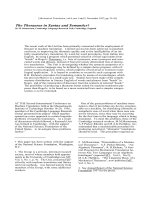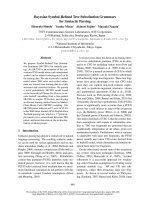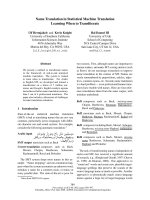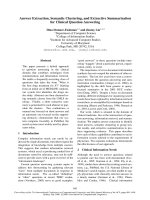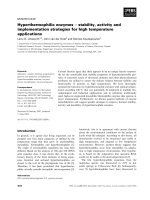Báo cáo khoa học: "Categorial Fluidity in Chinese and its Implications for Part-of-speech Tagging" pptx
Bạn đang xem bản rút gọn của tài liệu. Xem và tải ngay bản đầy đủ của tài liệu tại đây (273.5 KB, 4 trang )
Categorial Fluidity in Chinese and its Implications for
Part-of-speech Tagging
OiYeeKwong
Benjamin K. Tsou
Language Information Sciences Research Centre
City University of Hong Kong, Kowloon, Hong Kong
{rlolivia, rlbtsou}@cityu.edu.hk
Abstract
This
paper discusses the theoretical and
practical concerns in part-of-speech
(POS) tagging for Chinese. Unlike other
languages such as English, Chinese lacks
morphological marking in association
with categorial alternations. We consider
such categorial fluidity a continuum, and
any categorial shift a transition, with spe-
cial focus on the verb-noun shift. Pre-
liminary observations are reported on this
phenomenon from empirical data, and we
suggest that POS tagging should not only
be theoretically valid but also sufficiently
capture the extent of categorial fluidity as
reflected by the data.
1 Introduction
There are currently a number of POS-tagged
Chinese corpora available, based on different
tagsets and theoretical frameworks. Some are
more semantic-oriented in determining the syn-
tactic category of a word. For instance, CKIP
(1993) had a very fine-grained classification of
Chinese verbs based on thematic structures. Oth-
ers are mainly based on syntactic distribution
(e.g. Yu
et al.,
1998; Xia, 2000) where POS tags
are assigned mainly depending on the syntactic
properties of the target words.
Given the many-to-many relation between
grammatical function and lexical category in
Chinese, it is often not straightforward as to how
certain words should be tagged in particular sen-
tences. For example, should the verb
Ilk
huai2yi2
(to suspect) be given the same tag in all
cases in (1)
1
?
The digits following the Hanyu pinyin indicate the tone.
(1) a.
f-v-mt 'IBA (I
suspect
he is a thief)
wo3
huai2yi2 to] shi4 zei2
b. ftiORMV*M (He wears a
suspicious
look)
to] man3han3 huai2yi2 biao3qing2
c.
Rnfilm
(This is only my
suspicion)
zhe4 zhi3shi4 vvo3 de5 huai2yi2
Most Chinese grammarians would suggest that
Chinese words have predefined lexical categories
mainly based on their syntactic properties, which
should not be contingent upon the grammatical
function the words play in particular sentences
(e.g. Zhu, 2001). In this study, however, we will
show that categorial fluidity (i.e. the relative
flexibility of a word being used for different
grammatical functions) should be captured in the
tagging of large corpora to provide an important
resource for the study of this special linguistic
phenomenon, as well as for lexicography and
natural language processing.
In Section 2, we first discuss POS ambiguity
and categorial fluidity in Chinese and the diffi-
culty thus posed on tagging. Then in Section 3,
we report on a preliminary empirical study of the
categorial fluidity and shift between Chinese
verbs and nouns. The implications for POS tag-
ging are explored in Section 4, followed by a
conclusion with future work in Section 5.
2 POS Ambiguity in Chinese
2.1 The Difficulty
The major problem in POS tagging, for all lan-
guages alike, is probably that of ambiguity.
Where a word has multiple potential POS tags,
the ambiguity has to be resolved in context.
The problem of POS ambiguity is especially
salient for Chinese, mainly for two reasons.
First, categorial change in Chinese words is not
often associated with morphological marking.
115
Thus the same word form can have more than
one syntactic categories, and this difference is not
marked by any derivational affixes. For exam-
ple, the word
14
ling3dao3,
can be a verb (to
lead) or a noun (leader), as in (2).
(2) a.
04 rAt
(to lead the country forward)
ling3dao3 guo2jial yian2jin4
b.
fliIMMInft14 (He is our leader)
tal shi4 wo3men2 de5 ling3dao3
Second, the same Chinese word can have dif-
ferent grammatical functions in individual sen-
tences. There is no one-to-one relationship
between grammatical function and syntactic
category. As in (3), the word Ca (sing) is the
predicate in (a) but is the modifier in (b).
(3)a.
ftrga
(he sings)
to] chang4gel
b. 1:fia'a5 (singing skill)
chang4gel ji4giao3
2.2 Three Levels of Ambiguity
POS ambiguity is a serious problem for Chinese
in a small portion of the Chinese lexicon, but es-
pecially among the most frequently used lexical
items (Liu, 2000). Moreover, we may think of
categorial fluidity as a continuum, from genuine
ambiguities to specific cases of "word play".
Any categorial shift undergoes a transition, mov-
ing from the "word play" end toward the genuine
ambiguity end. Thus we distinguish three levels
of ambiguity, namely:
•
Regular ambiguity:
a word has multiple
POSs which are well accepted and described
in any existing lexicon, as in (4).
•
Transitional ambiguity: a word undergoes a
process of categorial shift, where it origi-
nally belongs to a particular syntactic cate-
gory and gradually assumes usage of another
category as well. Many prepositions in Chi-
nese are evolved from verbs, as in (5). Cate-
gorial shift from verb to noun is also
common, as discussed in the next section.
•
Innovative ambiguity:
sometimes words are
deliberately used in peculiar ways to create a
special effect, as in (6). Such individual
cases cannot be regarded as genuine ambi-
guity, until the special use becomes common
enough.
(4)a.
—Mb
-
(a piece ("spread") [of] tablecloth)
yil zhangl tai3bu4
b.
ORVRIA (rice ready open mouth)
fan4 lai2 zhangl kou3
c.
9EL
(Mr. Zhang)
zhangl xianlshengl
(5)a.
'FAVAAM
(sunlight passes through window)
yang2guangl tou4guo4 chuangl hu4
b.
(through
(through discussion find answer)
tou4guo4 tao3Ittn4 zhao3 da2an4
(6)
lad \j±
(He [is] very clown[ish])
tal hen3 xiao3chou3
As said, when innovative uses become fre-
quent enough, at some point they might be con-
sidered, or at least treated as, genuine
ambiguities. Nevertheless, it is the process of
transition that is of linguistic interest, and the
usage frequencies from corpus data gathered over
time would give good evidence for it. As a re-
sult, when tagging a corpus, the different uses of
the same word must be sufficiently represented to
enable this kind of longitudinal empirical study
to be carried out. In the following section, we
will first discuss a preliminary study along this
line, and then in Section 4, we will further dis-
cuss the implications on the requirements of PUS
tagging.
3 Categorial Fluidity and Shift
Very often when a verb is nominalised, it loses
part of a verb's syntactic features. For instance, a
nominalised transitive verb cannot take an object
in the normal VO order any more, as in (7).
(7)a.
& t.f.M
(produce influence)
chan3shengl ying3xiang3
*b.
& t.094VIA
(produce influence others)
chan3shengl ying3xiang3 bie2ren2
At the same time, it gains some syntactic features
of nouns, such as modification by adjectives or
numbers, as in (8).
(8)a. "6,VrM (one announcement)
yilxiang4 xuanlbu4
b.
;OMVII/T4
,
1
(one important announcement)
yilxiang4 zhong4yao4 de5 xuanlbu4
The asymmetry between nominalisation and ver-
balisation in Chinese was observed in Tai (1997).
116
In other words, verbs are more freely deverbal-
ised than nouns denominalised. This fluidity be-
tween verbal and nominal status of verbs can in
theory be generalised to many, if not all, verbs.
Nevertheless, does such categorial shift happen
to all verbs? What words undergo such shift and
how fast? At what point is the shift significant
enough to become genuine ambiguity? These
questions should be best answered by empirical
data.
3.1 A Preliminary Corpus-Based Study
As a preliminary study, we tagged a small subset
of the LIVAC corpus
2
(Tsou et al.,
2000) with an
earlier version of the tagset to be described in
Section 4.2. This subcorpus consists of newspa-
per texts from Hong Kong, with about 520K
word tokens and about 32K word types (exclud-
ing numbers). There are around 6.6K verbs, ex-
cluding auxiliary and copula verbs. Out of these,
672 were found also tagged nouns or nominalised
verbs. In other words, about 10% of all verbs in
the subcorpus were playing a role somewhere in
the verb-noun categorial shift.
A simple ratio (Eq.1) was computed for all the
672 verbs to give a picture of the categorial shift
as reflected by the preliminarily tagged data.
r = log (verb uses/noun uses)
(Eq.1)
The
log
ratio was used to give a linear scale. If
verb usage outnumbers noun usage to a certain
extent, i.e. when
r >> 0,
it suggests that the word
is originally a verb and has just started to shift. If
verb usage and noun usage are more or less equal,
i.e. when
r 0,
then either the shift is mature
enough or there is genuine ambiguity. Mean-
while, if noun usage outnumbers verb usage by a
lot, it would mean that either the verb has over
shifted or the word is originally a noun and is
occasionally denominalised (i.e. beginning to
shift).
Preliminary analysis of the data shows that
about 58% of the words have r > 0.3,
that is, verb
usage at least doubles noun usage for these words.
About 23% have
r
between —0.3 and 0.3. These
are the words of which verb usage and noun us-
age are quite balanced. The third group, with
r <
-0.3,
occupies about 17%. These words are more
2
/>used as nouns than verbs, at least twice as much.
A sample for each group with examples of verb
and noun usages is shown in (9), (10), and (11)
respectively. The above figures again reflect the
asymmetry between deverbalisation of verbs and
denominalisation of nouns.
(9)
r> 0.3
e.g.
INA
(to discover! discovery)
a.
W-
k
tARN,
(discovered by passers-by)
beil tu2ren2 fa1xian4
b.
Aforamm,
(have great discovery)
huo4de2 zhong4da4 fal xian4
(10)
-0.3
<r<0.3
e.g.
Ng
(to serve / service)
a.
w.Wz
-
,\,v,
(to serve the public)
fu2vvu4 gonglzhong4
b.
rgg,t$PW1M
(telephone counselling service)
dian4hua4,fu3dao3
.
fu2wu4
(11)
r -0.3
e.g.
rag
(to relate to / relation)
a.
1.rin
,
w1=1 Ic4.15))Anrizruig
(problems which relate to the political and economic
development of China)
yi1xie1 guan1x14 zhong 1 guo2 zheng4jing1 fa1zhan3
da4ju2 de5 wen4ti2
b.
4fai
l
fritiW; (friendly cooperative relation)
you3hao3 he2zuo4 guan1xi4
4 Implications for POS Tagging
Chinese POS tagging can so far be grouped into
two approaches. One holds that words have pre-
defined POSs independent of sentential contexts.
So as long as the form and the meaning do not
change, the POS does not change. Another ap-
proach is of the view that grammatical function
within a particular sentence determines POSs. So
a word is sometimes tagged as verb and some-
times as noun depending on its syntactic distribu-
tion in any given sentence. The debate between
the two approaches has never been settled, and in
this section we will discuss if there can be a
compromised approach by considering the prac-
tical and theoretical concerns of POS tagging.
4.1 Practical Concerns
There are at least two practical concerns in Chi-
nese POS tagging. First, we want to obtain in-
formation on the distribution of word uses. It
may defeat the purpose of corpus tagging if every
word is tagged independent of sentential con-
texts. Second, we need to distinguish between
different syntactic structures, as in (12).
117
(12)
cir,
pmc
hong2shao I pai2gu3
a.
V-0:
to roast
spare ribs
b.
Mod-Head:
roasted
spare ribs
If (12) is always tagged as a verb followed by a
noun, the two different readings cannot be distin-
guished. Hence apparently it would be preferable
to assign different tags to a word when it is used
in different syntactic distribution. However, this
introduces a crisis for the whole classification of
Chinese syntactic categories because any given
word cannot be prescribed a category and any
category cannot be adequately described. More-
over, it upsets the compactness and the organisa-
tion of the lexicon.
4.2 The Tagset
Hence even if the ambiguities are still in the tran-
sitional stage and should not be kept in the lexi-
con, it is still preferable to have them captured
and reflected in a tagged corpus.
Xia's (2000) approach does not accommodate
such transitional usages, but assigns a verb tag if
the word is used as a verb and a noun tag if it is
used as a noun. CKIP (1993) assigns the same
tag to the same word, but uses features to encode
specific grammatical functions, such as using
l+noml to indicate a nominalised usage of a verb.
For the current study, we reckon that the cate-
gorial fluidity information should be captured as
early as the tagging begins. So we attempted to
resolve the conflict between theoretical and prac-
tical concerns via the design of the tagset. In that
case the final lexicon would be theoretically valid
on the one hand, and the tagged corpus would be
of practical use for NLP tasks (e.g. parsing) on
the other. In our approach, each tag consists of a
letter code for the general classification (i.e.
noun, verb, etc.) of the word, and another for the
sub-classification according to the particular con-
text. For example, when a verb is used as the
subject on its own (i.e. no modification, not in a
phrase, etc.), we tag it as Vx. Thus on the one
hand we still recognise it as a verb, but on the
other hand we can distinguish it from its normal
form of usage. Moreover, theoretically we do not
treat it as nominalised but if for any practical rea-
son someone might want it this way, he or she
can easily extract all the Vx-tagged words and
mark them nouns.
5 Future Work and Conclusion
At present our tagset covers 14 general lexical
categories and altogether 43 small categories
(sub-classification). Both the tagset and the op-
erational guidelines have resulted from continu-
ous revision based on our experience of actually
tagging the corpus and observation of the cate-
gorial fluidity phenomenon.
The tagging task is ongoing with the latest re-
vised tagset and guidelines to produce a clean
and accurately tagged training corpus to be used
for the automatic tagging of the remaining cor-
pus. The long-term goal is to produce a very
large tagged corpus for use in lexicography and
other natural language processing tasks. Focus
will also be on a more detailed synchronous and
longitudinal study of the verb-noun and other
categorial shifts, with data from different regions
over time.
This paper has thus discussed POS ambiguity
on Chinese, with a focus on the categorial shift
from verbs to nouns, and the implications this
phenomenon might have for POS tagging.
References
Chinese Knowledge Information Processing Group (CKIP).
1993.
iirt,
-
=,m,3.
-
}K (EN)
Technical Report no.93-
05, Academia Sinica, Taiwan.
Liu, K. 2000.
Zhongwen Wenben Zidong Fenci He Biaozhu.
Beijing: Commercial Press.
Tai, J.H-Y. 1997. Category Shifts and Word-Formation
Redundancy Rules in Chinese. (
tvgrigritiEw
n
v,.
g,) ,
3: 435-468.
Tsou, B.K., Tsoi, W.F., Lai, T.B.Y., Hu, J. and Chan,
S.W.K. 2000. LIVAC, A Chinese Synchronous Corpus,
and Some Applications. In
Proceedings of the ICCLC
International Conference on Chinese Language Comput-
ing,
Chicago, pages 233-238.
Xia, F. 2000.
The Part-Of-Speech Tagging Guidelines for
the Penn Chinese Treebank (3.0). IRCS Technical Report
IRCS-00-07. Institute for Research in Cognitive Science,
University of Pennsylvania.
Yu, S., Zhu, X. and Li, F. 1998. Representation of Gram-
matical Knowledge in the Chinese Lexicon. In B.K.
T' sou, T.B.Y. Lai, S.W.K. Chan and W.S-Y. Wang
(Eds.),
Quantitative and Computational Studies on the
Chinese Language,
pages 353-372.
Zhu, D. 2001.
Xiandai Hanyu Yufa Yanjiu.
Beijing: Com-
mercial Press.
118




